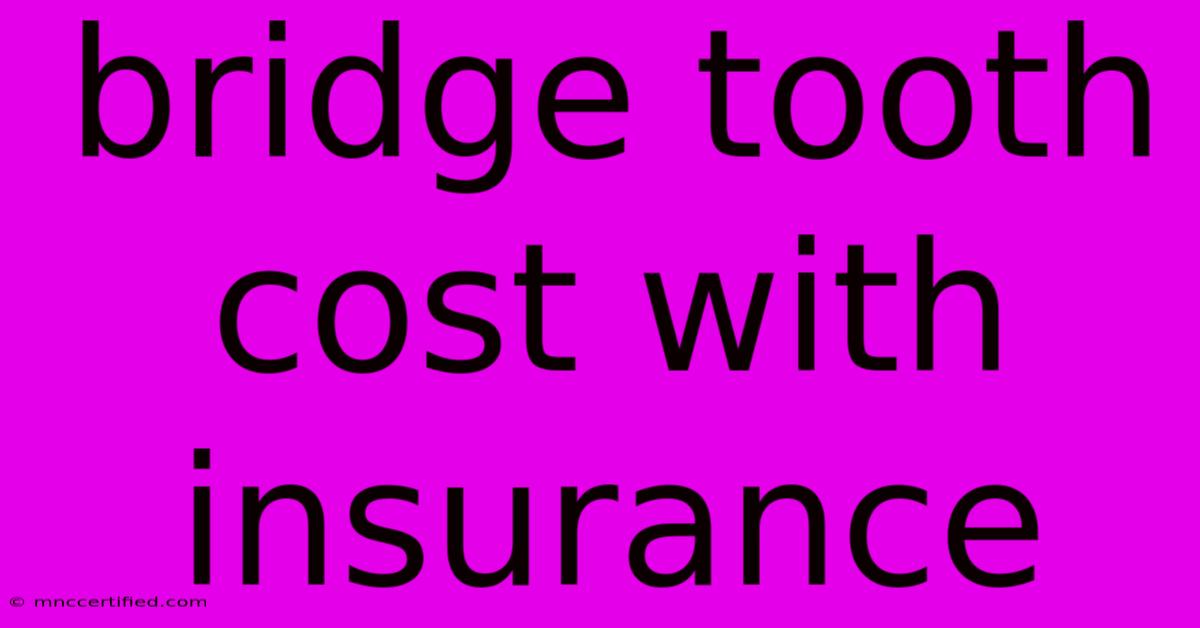Bridge Tooth Cost With Insurance

Table of Contents
Bridge Tooth Cost with Insurance: A Comprehensive Guide
Getting a dental bridge can significantly improve your smile and oral health, restoring functionality and aesthetics. However, the cost of a dental bridge can be substantial. Understanding how dental insurance impacts the overall expense is crucial before you commit to treatment. This comprehensive guide will break down the cost of a bridge tooth, explore how insurance coverage works, and offer strategies to manage the expenses effectively.
Understanding the Cost Factors
The price of a dental bridge varies considerably depending on several factors:
-
Type of Bridge: Different types of bridges exist, each with varying costs. These include traditional bridges, Maryland bonded bridges, and cantilever bridges. Traditional bridges, the most common type, involve crowns on the abutment teeth (the teeth on either side of the gap) and a pontic (the artificial tooth replacing the missing one). Maryland bonded bridges use a metal or porcelain framework bonded to the abutment teeth, generally less expensive than traditional bridges. Cantilever bridges, used when only one abutment tooth is available, are less common and often more expensive.
-
Materials: The materials used in constructing the bridge significantly impact the cost. Porcelain fused to metal (PFM) bridges offer a balance of strength and aesthetics, while all-porcelain bridges are more aesthetically pleasing but generally more expensive. Metal bridges, while durable and less costly, are rarely used today due to their less natural appearance.
-
Number of Teeth Replaced: The more teeth the bridge replaces, the higher the cost will be. A single-tooth bridge will naturally be cheaper than a bridge replacing multiple teeth.
-
Dentist's Location and Fees: Geographic location and the individual dentist's fees play a crucial role in determining the final cost. Dentists in urban areas or those with specialized expertise often charge more.
-
Additional Procedures: Extractions, gum treatments, or bone grafts may be necessary before bridge placement, adding to the overall cost.
How Dental Insurance Affects the Cost
Most dental insurance plans cover a portion of the cost of dental bridges, but the extent of coverage varies widely depending on your plan's specifics. Here's what you need to know:
-
Check Your Policy: Carefully review your insurance policy to understand your coverage limits, annual maximums, and any waiting periods before major restorative procedures like bridge placement. Look for terms like "major restorative," "prosthodontics," or "crown and bridge" to determine your benefits.
-
Annual Maximums: Your insurance may have an annual maximum, meaning there's a limit to how much they'll pay out in a year. If the total cost of your bridge exceeds this limit, you'll be responsible for the remaining balance.
-
Deductibles: You'll likely have a deductible you need to meet before your insurance starts covering any expenses.
-
Co-payments and Co-insurance: After meeting your deductible, you'll probably pay a co-payment or co-insurance for each visit and for the bridge itself. This is typically a percentage of the cost.
-
Pre-authorization: Some insurance plans require pre-authorization for major procedures like bridges. Contact your insurer before scheduling your procedure to confirm coverage and avoid unexpected bills.
Strategies for Managing the Cost
-
Payment Plans: Many dentists offer in-house payment plans to help you manage the cost of treatment. Explore these options and compare interest rates.
-
Financing Options: Third-party financing companies specialize in providing loans for dental procedures. Shop around and compare interest rates and repayment terms before committing.
-
Negotiate with Your Dentist: Discuss your financial constraints openly with your dentist. They may be able to work with you to create a payment plan or adjust treatment to reduce the overall cost.
-
Explore Alternative Treatments: In some cases, dental implants or partial dentures might be viable alternatives, offering different cost structures. Discuss these options with your dentist.
-
Shop Around: Get estimates from multiple dentists to compare pricing and coverage options.
Conclusion: Planning for a Bridge
The cost of a bridge tooth can be significant, but understanding your insurance coverage and employing effective cost-management strategies can help make the process more manageable. Thorough planning, open communication with your dentist and insurance provider, and exploring all available options will enable you to get the dental care you need without breaking the bank. Remember to always carefully review your insurance policy and seek clarification on any unclear aspects of your coverage before starting treatment.

Thank you for visiting our website wich cover about Bridge Tooth Cost With Insurance. We hope the information provided has been useful to you. Feel free to contact us if you have any questions or need further assistance. See you next time and dont miss to bookmark.
Featured Posts
-
Penn Dot Prepares For Winter Roads
Nov 21, 2024
-
Insurance Cover Skin Tag Removal
Nov 21, 2024
-
Racing On Tv November 15 17 Schedule
Nov 21, 2024
-
Pulsechain Price Prediction 2025
Nov 21, 2024
-
Catawba College Insurance Waiver
Nov 21, 2024